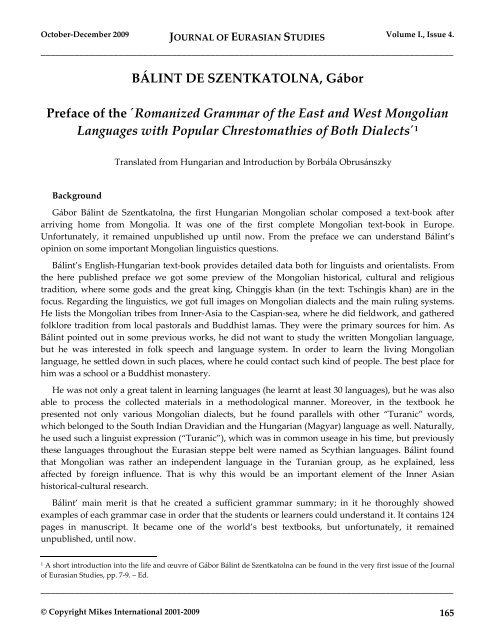JOURNAL OF EURASIAN STUDIES
JOURNAL OF EURASIAN STUDIES
JOURNAL OF EURASIAN STUDIES
You also want an ePaper? Increase the reach of your titles
YUMPU automatically turns print PDFs into web optimized ePapers that Google loves.
October-December 2009 <strong>JOURNAL</strong> <strong>OF</strong> <strong>EURASIAN</strong> <strong>STUDIES</strong> Volume I., Issue 4.<br />
_____________________________________________________________________________________<br />
BÁLINT DE SZENTKATOLNA, Gábor<br />
Preface of the ´Romanized Grammar of the East and West Mongolian<br />
Languages with Popular Chrestomathies of Both Dialects´ 1<br />
Background<br />
Translated from Hungarian and Introduction by Borbála Obrusánszky<br />
Gábor Bálint de Szentkatolna, the first Hungarian Mongolian scholar composed a text-book after<br />
arriving home from Mongolia. It was one of the first complete Mongolian text-book in Europe.<br />
Unfortunately, it remained unpublished up until now. From the preface we can understand Bálint’s<br />
opinion on some important Mongolian linguistics questions.<br />
Bálint’s English-Hungarian text-book provides detailed data both for linguists and orientalists. From<br />
the here published preface we got some preview of the Mongolian historical, cultural and religious<br />
tradition, where some gods and the great king, Chinggis khan (in the text: Tschingis khan) are in the<br />
focus. Regarding the linguistics, we got full images on Mongolian dialects and the main ruling systems.<br />
He lists the Mongolian tribes from Inner-Asia to the Caspian-sea, where he did fieldwork, and gathered<br />
folklore tradition from local pastorals and Buddhist lamas. They were the primary sources for him. As<br />
Bálint pointed out in some previous works, he did not want to study the written Mongolian language,<br />
but he was interested in folk speech and language system. In order to learn the living Mongolian<br />
language, he settled down in such places, where he could contact such kind of people. The best place for<br />
him was a school or a Buddhist monastery.<br />
He was not only a great talent in learning languages (he learnt at least 30 languages), but he was also<br />
able to process the collected materials in a methodological manner. Moreover, in the textbook he<br />
presented not only various Mongolian dialects, but he found parallels with other “Turanic” words,<br />
which belonged to the South Indian Dravidian and the Hungarian (Magyar) language as well. Naturally,<br />
he used such a linguist expression (“Turanic”), which was in common useage in his time, but previously<br />
these languages throughout the Eurasian steppe belt were named as Scythian languages. Bálint found<br />
that Mongolian was rather an independent language in the Turanian group, as he explained, less<br />
affected by foreign influence. That is why this would be an important element of the Inner Asian<br />
historical-cultural research.<br />
Bálint’ main merit is that he created a sufficient grammar summary; in it he thoroughly showed<br />
examples of each grammar case in order that the students or learners could understand it. It contains 124<br />
pages in manuscript. It became one of the world’s best textbooks, but unfortunately, it remained<br />
unpublished, until now.<br />
1 A short introduction into the life and œuvre of Gábor Bálint de Szentkatolna can be found in the very first issue of the Journal<br />
of Eurasian Studies, pp. 7-9. – Ed.<br />
_____________________________________________________________________________________<br />
© Copyright Mikes International 2001-2009 165
















